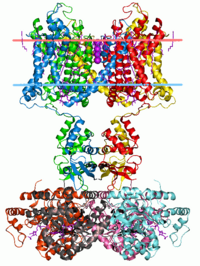User:Rachelko/sandbox
| Ion channel | |||||||||||
|---|---|---|---|---|---|---|---|---|---|---|---|
 Bla Bla voltage-gated ion channel | |||||||||||
| Identifiers | |||||||||||
| Symbol | Ion_trans | ||||||||||
| Pfam | PF00520 | ||||||||||
| InterPro | IPR005821 | ||||||||||
| SCOP2 | 1bl8 / SCOPe / SUPFAM | ||||||||||
| TCDB | 1.A.1 | ||||||||||
| OPM superfamily | 8 | ||||||||||
| OPM protein | 2a79 | ||||||||||
| |||||||||||
| Ion channel (bacterial) | |||||||||||
|---|---|---|---|---|---|---|---|---|---|---|---|
 Voltage-gated channel .... | |||||||||||
| Identifiers | |||||||||||
| Symbol | Ion_trans_2 | ||||||||||
| Pfam | PF07885 | ||||||||||
| InterPro | IPR013099 | ||||||||||
| SCOP2 | 1bl8 / SCOPe / SUPFAM | ||||||||||
| OPM protein | 1r3j | ||||||||||
| |||||||||||
| Slow voltage-gated potassium channel (Potassium channel, voltage-dependent, beta subunit, KCNE) | |||||||||
|---|---|---|---|---|---|---|---|---|---|
| Identifiers | |||||||||
| Symbol | ISK_Channel | ||||||||
| Pfam | PF02060 | ||||||||
| InterPro | IPR000369 | ||||||||
| TCDB | 8.A.10 | ||||||||
| |||||||||
| KCNQ voltage-gated potassium channe | |||||||||
|---|---|---|---|---|---|---|---|---|---|
| Identifiers | |||||||||
| Symbol | KCNQ_channel | ||||||||
| Pfam | PF03520 | ||||||||
| InterPro | IPR013821 | ||||||||
| |||||||||
| Kv2 voltage-gated K+ channel | |||||||||
|---|---|---|---|---|---|---|---|---|---|
| Identifiers | |||||||||
| Symbol | Kv2channel | ||||||||
| Pfam | PF03521 | ||||||||
| InterPro | IPR003973 | ||||||||
| |||||||||
TEST
Voltage-gated ion channels are a class of transmembrane ion channels that are activated by changes in electrical membrane potential near the channel; these types of ion channels are especially critical in neurons, but are common in many types of cells.
They have a crucial role in excitable neuronal and muscle tissues, allowing a rapid and co-ordinated depolarization in response to triggering voltage change. Found along the axon and at the synapse, voltage-gated ion channels directionally propagate electrical signals.
Structure
[edit]They generally are composed of several subunits arranged in such a way that there is a central pore through which ions can travel down their electrochemical gradients. The channels tend to be ion-specific, although similarly sized and charged ions may sometimes travel through them.
Examples include:
- the sodium and potassium voltage-gated channels of nerve and muscle.
- the voltage-gated calcium channels that play a role in neurotransmitter release in pre-synaptic nerve endings.
Mechanism
[edit]From crystallographic structural studies of a potassium channel, assuming that this structure remains intact in the corresponding plasma membrane, it is possible to surmise that when a potential difference is introduced over the membrane, the associated electromagnetic field induces a conformational change in the potassium channel. The conformational change distorts the shape of the channel proteins sufficiently such that the cavity, or channel, opens to admit ion influx or efflux to occur across the membrane, down its electrochemical gradient. This subsequently generates an electrical current sufficient to depolarise the cell membrane.
Voltage-gated sodium channels and calcium channels are made up of a single polypeptide with four homologous domains. Each domain contains 6 membrane spanning alpha helices. One of these helices, S4, is the voltage sensing helix.[1] It has many positive charges such that a high positive charge outside the cell repels the helix, keeping the channel in its closed state. Depolarization of the cell interior causes the helix to move, inducing a conformational change such that ions may flow through the channel (the open state). Potassium channels function in a similar way, with the exception that they are composed of four separate polypeptide chains, each comprising one domain.
The voltage-sensitive protein domain of these channels (the "voltage sensor") generally contains a region composed of S3b and S4 helices, known as the "paddle" due to its shape, which appears to be a conserved sequence, interchangeable across a wide variety of cells and species. A similar voltage sensor paddle has also been found in a family of voltage sensitive phosphatases in various species.[2] Genetic engineering of the paddle region from a species of volcano-dwelling archaebacteria into rat brain potassium channels results in a fully functional ion channel, as long as the whole intact paddle is replaced.[3] This "modularity" allows use of simple and inexpensive model systems to study the function of this region, its role in disease, and pharmaceutical control of its behavior rather than being limited to poorly characterized, expensive, and/or difficult to study preparations.[4]
References
[edit]- ^ Voltage sensor in the voltage gated sodium and potassium channels | PharmaXChange.info
- ^ Murata, Y.; Iwasaki, H.; Sasaki, M.; Inaba, K.; Okamura, Y. (2005). "Phosphoinositide phosphatase activity coupled to an intrinsic voltage sensor". Nature. 435 (7046): 1239–1243. doi:10.1038/nature03650. PMID 15902207.
- ^ Alabi AA, Bahamonde MI, Jung HJ, Kim JI, Swartz KJ (November 2007). "Portability of paddle motif function and pharmacology in voltage sensors". Nature. 450 (7168): 370–5. doi:10.1038/nature06266. PMC 2709416. PMID 18004375.
{{cite journal}}: CS1 maint: multiple names: authors list (link) - ^ Long SB, Tao X, Campbell EB, MacKinnon R (November 2007). "Atomic structure of a voltage-dependent K+ channel in a lipid membrane-like environment". Nature. 450 (7168): 376–82. doi:10.1038/nature06265. PMID 18004376.
{{cite journal}}: CS1 maint: multiple names: authors list (link)
See also
[edit]- Ion channel
- Voltage-dependent calcium channel
- Voltage-gated proton channel
- Voltage-gated potassium channel
- Sodium ion channel
- Potassium channel
- Catecholaminergic polymorphic ventricular tachycardia
External links
[edit]- IUPHAR-DB Voltage-gated ion channel subunits
- The IUPHAR Compendium of Voltage-gated Ion Channels 2005
- Voltage-Dependent+Anion+Channels at the U.S. National Library of Medicine Medical Subject Headings (MeSH)
Category:Ion channels Category:Electrophysiology Category:Integral membrane proteins

